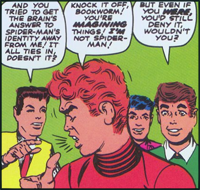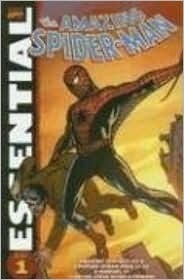Reading The Amazing Spider-Man: Issue Number Eight Part One
Reading The Amazing Spider-Man this time around, we're treated to a special "Tribute to Teen-Agers" issue with a primary story set entirely at Midtown High and a backup tale (which we'll tackle in the next installment) featuring the Human Torch. As always, we'll look at this issue with an eye toward discovering what one of the most enduring story franchises of the modern era can teach us about developing our own storyworlds.
Part one of issue eight of The Amazing Spider-Man deals with "The Terrible Threat of the Living Brain!" The splash page shows a green boxy robot with stumpy ball-bearing legs and whirling arms menacing a quartet of cowering school kids while Spider-Man leaps at the thing from behind. The caption promises the long-foreshadowed fight between Peter Parker and Flash Thompson, a fight between Spider-Man and a non-human menace (I guess the Lizard didn't count?) and, of course, "a tale of sheer fantasy, so real you'll feel it's happening to you!"
Let's see about that!
Synopsis
All the antagonists of the issue are introduced in the very first panel — the "living brain" robot, wheeled into the science class at Midtown High School by two brutish laborers, and Flash Thompson, Peter Parker's long-time rival. We also get the first real indicator of Peter Parker's age: the caption reads "In the senior science class at Midtown High School…" If he's a senior in high school, and not a sophomore as I previously assumed, Peter must be about seventeen years old.
Flash Thompson mocks Peter's appreciation of the robot to the point of giving him a shove that knocks Peter's glasses off. The glasses shatter on the floor, which is the last straw for Peter. When Flash threatens to beat him up after class, Peter retorts that Flash has "a little surprise coming." Peter's fed up. He thinks:
I've had it! I'm through pretending to be a pantywaist to conceal my real identity! I don't need those specs anyway!
The teacher, Mister Warren (not the same Professor Warren who will cause lots of problems for the amazing Spider-Man in a few years), calls the class to order and introduces Mr. Petty from the I.C.M. corporation, who is there to demonstrate the robot. Petty gives the class a run-down of the machine — it's the most sophisticated electronic brain yet devised, and is housed in "the form of a human body" (sort of) in order to dramatize its power.
The teacher selects Peter to assist Perry in demonstrating the Living Brain. Flash, naturally, teases Peter for a teacher's pet, but the secretly brainy Liz Allen shushes him — she wants to see what's going to happen.
While Peter gets up to speed on operating the Living Brain, the two thugs figure out that if they were to steal the thing, they could use it to predict horse races, lotteries and the like. They agree to grab the refrigerator-sized robot as soon as possible.
The class decided Peter should ask the Living Brain to determine the true identity of their favorite super-hero, the amazing Spider-Man. They feed in everything they know about him:
He's about five feet ten inches tall!
Weight about one-hundred sixty pounds!
He's been sighted in the Forest Hills area a lot!
He's the most wonderful, heroic, glamorous man in the whole world!
If you ask me, he's a neurotic nut!
If you ask me, they don't need a big green robot to suss this one out. After all, apart from Liz Allen's gushing, they've just described Peter Parker. Apparently the class of '63 wasn't known for its deductive reasoning abilities.
Peter, sweating visibly, feeds the clues into the machine. The Living Brain doesn't take any time at all spitting out the answer on a strip of paper. Fortunately, it's presented in the form of "mathematical code symbols" that Peter is to decode overnight.
Let's pause for a moment here for a ridiculosity check. In the Living Brain, we have a device that is apparently one of the most sophisticated computers in the world. In order to demonstrate its utility, I.C.M. designed a very advanced robot body for the thing. Despite all this… they didn't bother to include human-readable output. Huh?
Also… in the young Marvel Universe in New York City in late 1963, J. Jonah Jameson's rants in The Daily Bugle and Now Magazine have everyone talking about the amazing Spider-Man. He's kind of a big deal. Discovering his true identity would be the story of the year. Either Mr. Perry honestly doesn't care about the publicity to be had in his company's product unmasking Spider-Man, or he doesn't sincerely believe the thing can figure it out given the information provided. Otherwise, why on earth would he leave that data with a high school student?
Ridiculous.
At least Flash Thompson recognizes the importance of that slip of paper — he tries to get it off Peter so he can decode it himself.
Peter can't have that. Furious and a little desperate, he physically holds Flash back from taking the paper.
The teacher finally intervenes. He's seen these two verbally sparring for months, and now they're close to getting physically violent with each other. The most responsible thing this science teacher can come up with is to have the two kids duke it out in a controlled environment: he insists they settle their differences in the boxing ring in the school gym.
By the way, did your high school have a boxing ring? 'Cause mine sure didn't. We had "under the bleachers, after school!"
"And so, after class," Peter and Flash suit up for their match. Despite Peter Parker's well-defined biceps and six pack abs, kids call him "stringbean." Folks see what they want to see, I guess.
Flash and Peter get into the ring. Flash goes on the offensive immediately, but Peter's spider-sense is so effective he dodges every blow. Unfortunately, the kids watching take this to be cowardice on Peter's part. Even Flash urges him to "c'mon and fight."
Partially for show and, let's face it, mostly because he wants to, Peter swings at Flash. To protect Flash from his spider-strength and to protect his own identity, Peter pulls his punch, putting "only the smallest fraction" of his strength into play. It's still enough to blast poor Flash all the way through the ropes and out of the ring.
Flash, groggy and confused, convinces himself that it was a lucky punch and that he tripped over the ropes. He goes in for more… but before we find out what happens, it's time to switch scenes.
On the floor above the gym, the two "technicians" decide the time is right to abscond with the Living Brain. Petty interrupts them; they knock him out… but in the scuffle, one of the bad guys bumps into the Brain's control panel.
That's all it takes for the most sophisticated computer in the world to "short circuit." It starts swinging its ball bearing sockets at blinding speed and making its way through the school, running wild and out of control.
"While in the gym below, the fight goes on…"
Peter's figured out how he can hit Flash without killing him — he'll slap him with a flip of his wrist, rather than punching with the force of his whole arm. Just when Peter's about to deliver what he hopes will be the blow that will settle their rivalry and release him from his pariah status once and for all, Flash is distracted by someone crying out about the Living Brain's rampage.
Flash turns his head in the direction of the scream… and Peter can't stop his slappy-punch. Pow. Down goes Flash… and the schoolkids cry foul, since Flash wasn't looking.
The kids don't have much time to put Peter through the ringer, what with that nasty green robot on the loose. They scatter, which gives Peter time to drop off the unconscious Flash in the locker room, change into Spider-Man, and hunt down the Living Brain.
Seven and a half pages of fight scenes follow. The challenge for Spider-Man is that the Living Brain remembers everything — you can't use the same strategy twice because it will learn and adapt accordingly. It also adjusts its strength based on necessity, which means it doesn't take long for it to figure out exactly how much force to use to break Spider-Man's webbing.
Finally, risking a pummeling, the amazing Spider-Man manages to leap atop the Living Brain, where, leaning forward, he can reach the robot's control panel and flip the "main cut-off switch," making the Living Brain "incapable of further independent action."
Unfortunately, Spider-Man succeeds in this just as the Living Brain's momentum takes it — and Spider-Man, pinned by its arms — down a staircase. Fortunately, Spider-Man manages to snag a web-line on the stairwell that supports them both. They swing back and forth for a bit before finally coming to a stop. The Living Brain has been immobilized.
Even though they've had more than seven pages to do it, the two thugs that caused all this trouble still haven't found their way out of the labyrinthine halls of Midtown High. They burst through the locker room door just as the recently revived Flash Thompson is bending over to tie his shoe.
Wham! The bad guys tumble right over him and manage to knock themselves out. Flash, eager to save face after getting his clock cleaned by "puny" Peter Parker, takes credit for incapacitating the thugsd when his classmates show up moments later.
 Peter sees an opportunity for some mischief. He points out to everyone that Flash was the only one (more or less) not around while Spider-Man and the Living Brain were fighting… and he knocked out two ruffians with no trouble at all… and hey, why was he so eager to get the slip of paper possibly revealing Spider-Man's real identity away from Peter?
Peter sees an opportunity for some mischief. He points out to everyone that Flash was the only one (more or less) not around while Spider-Man and the Living Brain were fighting… and he knocked out two ruffians with no trouble at all… and hey, why was he so eager to get the slip of paper possibly revealing Spider-Man's real identity away from Peter?
The other kids pick up on it, for it also explains why Flash lost the fight with Peter — so no one would suspect the truth. While Flash sputters and frantically denies it, Peter makes his exit. He decides he'll say he lost the Living Brain's data printout in the chaos, and that, as they say, will be that.
Never mind that he's not even curious to find out if the damn thing got the answer right, since, conceivably, the same data could be entered into the robot again, at any time. The I.C.M. corporation controls a machine that could expose him at any moment… and Peter Parker walks home from school literally whistling a jaunty tune. The end.
Thoughts On Issue Eight Part One of The Amazing Spider-Man
Two important things happen in this issue: Peter Parker's glasses break (he'll never wear glasses again) and the long-promised plot thread of his fight with Flash Thompson is resolved. Other than that, this issue felt very much like filler. Maybe the creators' attentions were on one of the other comics Marvel put out that month?
Strictly from quality side of things, much ground was lost with this tale… and as we'll see in the the next installment of this blog series, the second story in this issue didn't do anything to get it back.
The lesson for storyworld and story franchise creation? Sometimes you have to have filler… in fact, you should have some "stand-in" story content in your catalog to cover in case of rare and unavoidable delays and problems.
That said, best be sure you don't equate "filler" with "sub-par." Every installment of your story, whether it's an issue of a comic book, an episode of a television show, or a sequence in a video game, should build momentum and, ideally, audience and loyalty. Don't sacrifice that momentum with a stop-gap.
Next time, we'll tackle the second story in issue number eight of The Amazing Spider-Man, a little tale featuring Spider-Man's pal the Human Torch. And still yet more teen-agers. Cripes.
The Amazing Spider-Man number eight part one
"The Terrible Threat of the Living Brain"
Cover Date: December, 1963
Script: Stan Lee
Art: Steve Ditko
Letters: Artie Simek
Join Me In Reading The Amazing Spider-Man
Click the cover to buy the first twenty issues of The Amazing Spider-Man in an inexpensive trade paperback from Barnes & Noble Booksellers:

Your purchase helps support this series and all my creative endeavors — thanks!
Matthew Wayne Selznick - Telling stories with words, music, pictures and people.






[image error]



